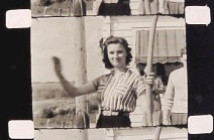LOVE PAGEANT RALLY
Unknown filmmaker, 1966, 16mm, silent with new score by Peter Sheffer, 3:49
Location: San Francisco, California
Shown at Home Movie Day San Francisco
Transfer by Movette Film Transfer
Film courtesy of the San Francisco Media Archive
www.sfm.org
Copyright San Francisco Media Archive
Thanks to: Stephen Parr, Aaron Rietz, Kathleen Maguire
About the Film
On October 6, 1966, the day LSD was made illegal in California a group of hippies, said to fall somewhere around 1,000 in number, gathered on San Francisco’s Panhandle for the Love Pageant Rally. The organizers, Allen Cohen and Michael Bowen, were key figures with the San Francisco Oracle (12 issues between September 1966 and February 1968), an underground publication credited for shaping Haight-Ashbury’s burgeoning counterculture. Cohen and Bowen framed the event not as a protest, but as a celebration of “transcendental consciousness” and the “beauty of being.”
While less known than events that followed, this gathering marked a seminal moment in the counterculture revolution of the 1960s. This short document of the Love Pageant Rally features several notable figures from the Haight-Ashbury scene at the time. Striking in the film is how clearly the movement is on the cusp of both of breaking through and falling, if not apart, at least away from its idyllic core. There are two primary focuses in its three minutes: Ken Kesey’s Merry Pranksters and a performance by Big Brother and the Holding Company featuring Janis Joplin. Some groovy dancing does receive significant screen time, but for the sake of this brief essay, lets imagine they’re grooving to Big Brother. The differences between where each stood in regards to their participation in hippie culture presents an interesting glimpse at the seismic shift the countercultural revolution rested at the edge of.
The film begins with Ken Kesey’s “Further” bus and the Merry Pranksters. Most widely remembered as the author of One Flew Over the Cuckoo’s Nest, Kesey – and Further – were later immortalized for their central place in the countercultural revolution through Tom Wolfe’s Electric Kool-Aid Acid Test. The bus had only recently returned–along with a few Merry Pranksters–from Mexico where Kesey was on the lam to avoid a charge of possession of marijuana. From its founding in 1964, the Further bus was a mobile headquarters for the Merry Pranksters to share their goal of taking people “further” into a mind-shifting expanded reality. This goal was often aided by their dispersal of free LSD, and their famed Acid Tests, which the illegalization of LSD criminalized in an instant. Just weeks after this rally, an Acid Test Graduation was held in San Francisco on Halloween.
After lingering on the bus and the Merry Pranksters draped on and around it, a cut brings us to the performances at the event, which included the Grateful Dead (not seen). First, a group of African-American jazz musicians – possibly the Joe Henderson Quartet – are spied briefly, before we see Big Brother and the Holding Company. After relocating from San Francisco back to her native Texas for several years, Janis Joplin had returned to the Bay Area earlier that year and had been performing with the Big Brother and the Holding Company. At the time of this performance, the group, including Joplin, were relatively unknown beyond the Bay Area, and had just returned from Chicago where they had recorded a handful of songs that would appear on their debut album. They were, however, central to the psychedelic music scene in the area and appeared at events that followed the Love In, including the Acid Test Graduation and the Be-In, a similar gathering organized by Michael Bowen in Golden Gate Park.
While hippie culture is often idealized, it seems rare to find documents like this one – where it truly feels idyllic. Although recorded in the heart of the Haight just months before the Summer of Love, the Love Pageant Rally has the feel of a neighborhood party (albeit, a neighborhood party in Haight-Ashbury). The camerawork, while shaky, is intimate. The filmmaker appears to be not just an observer, but a participant. While the Rally has an air of committed participation that is often diluted as movements are more widely popularized, the forthcoming shift can be found in the few outsider observers seen: the media. Multiple other professional looking film crews are visible, showing an understanding that something–beyond just the change to LSD regulations–was brewing.
Whether or not that something that brewed misplaced the grand intentions of those at its originating core is too big of questions for this space. But, in regards to our totems of the film, after the Acid Test Graduation, most of the Merry Pranksters would relocate to Kesey’s Oregon farm in advance of the Summer of 1967. Kesey would give himself up and serve his jail time. The Merry Pranksters still were devoted to their ideas and ideals but were removed from where the action would soon explode. Big Brother and the Holding Company would continue to be important figures in the movement, garnering increased popularity following a performance at Monterey Pop, one of the originating events of the Summer of Love, in June of 1967. In Joplin’s case this popularity would only reach its peak following her death in 1970.
–Kathleen Maguire
About the Music
Peter Sheffer is the lead singer and washtub bass player in the Los Angeles-based death folk band Los Duggans. He lives in Homer, Alaska.

